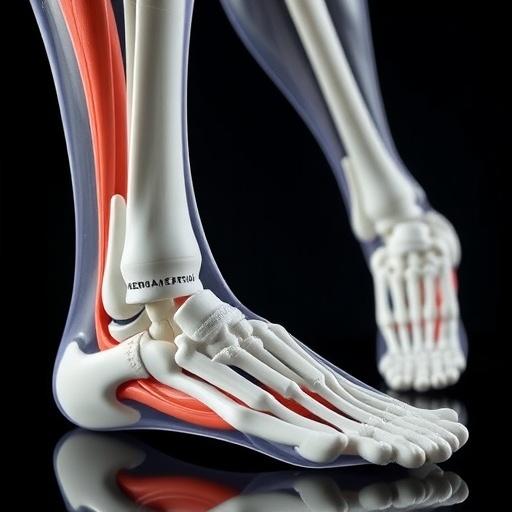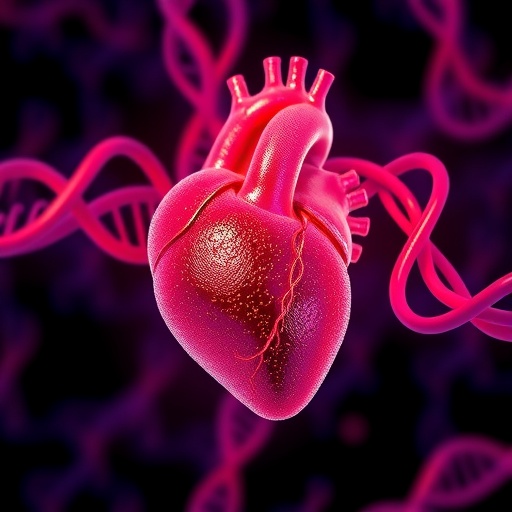In the ever-evolving field of biomedical engineering, new methods and models play a critical role in understanding the complex architecture of human muscles. Recently, a groundbreaking study has emerged, revealing insights into the medial gastrocnemius muscle through an innovative statistical shape and fiber orientation model. Authors Bin Ghouth, T. Besier, and G. Handsfield have contributed substantial findings that promise to impact our understanding of muscular architecture, biomechanics, and potential clinical applications. This research not only adds a new dimension to our anatomical knowledge but also paves the way for future advancements in rehabilitation and sports science.
The medial gastrocnemius, a prominent muscle located in the calf region, plays a vital role in various lower-extremity movements. It aids in actions such as walking, running, and jumping. To fully appreciate the intricacies of this muscle, researchers have historically relied on traditional anatomical assessments, which often overlook its three-dimensional structure. This limitation has hindered the potential for developing accurate models that could enhance our understanding and assist in improving therapeutic interventions. Hence, the need for a more robust approach to characterize this muscle was evident.
The study introduces a statistical shape model that enhances the existing comprehension of the medial gastrocnemius. This innovative model leverages advanced statistical techniques to incorporate variability in muscle shape and fiber orientation, providing a comprehensive view that traditional assessments cannot achieve. The research team meticulously collected data from a diverse population sample, ensuring that the model reflects anatomical variations present across different individuals. This attention to variability is crucial in establishing a model that can be universally applied.
Furthermore, the study employs cutting-edge imaging techniques to gather precise measurements of the muscle’s architecture. Utilizing methods such as MRI and ultrasound, researchers captured detailed images that illustrate the muscle’s structure, including its fiber orientation and geometric shape. By processing this information through sophisticated algorithms, the statistical models shift from mere representations to robust predictions of muscle function in various contexts.
The implications of this research extend beyond mere anatomy. By understanding the architectural properties of the medial gastrocnemius, biomechanists and rehabilitation specialists can better assess how variations in muscle structure might influence performance and injury risk. For instance, specific fiber orientations may predispose certain individuals to injuries during high-impact activities. This newfound understanding opens opportunities for injury prevention strategies tailored to individual anatomical profiles.
Moreover, the statistical shape model also holds promise for enhancing athletic training programs. Coaches and trainers can utilize insights from this research to design exercises that optimize muscle performance based on an athlete’s unique structural characteristics. By honing in on individualized training regimens, athletes can potentially improve their performance while minimizing the risk of overtraining injuries.
As the authors highlight, the integration of statistical models in understanding muscle architecture could transform the field of rehabilitation. Traditional approaches often emphasize standardized protocols, potentially neglecting variations in individual anatomy. With the application of insights from this study, rehabilitation specialists can personalize recovery plans, ensuring that they align with each patient’s specific anatomical needs. This paradigm shift in rehabilitation practices heralds a more effective approach to restoring function and enhancing mobility.
Interestingly, the research’s findings also have broad implications for the field of biomechanics. By providing a refined understanding of muscle architecture, the study aids in developing more accurate computational models of human movement. These models could serve as foundational tools for simulating various activities, leading to advancements in fields such as robotics and prosthetic development. Accurate models of muscle function may also propel innovations in biomechanical assessments in clinical settings, providing better diagnostic tools for muscle-related conditions.
In light of the significant findings from this research, it becomes evident that the statistical shape and fiber orientation model may contribute to broader applications in medical science. Understanding the structural attributes of the medial gastrocnemius could aid in diagnosing and treating conditions such as muscular dystrophy or other muscle-related pathologies. Furthermore, the model may assist researchers in exploring the effects of aging on muscle architecture, paving the way for interventions that promote healthy aging and maintain functional mobility.
As research continues to advance in this area, it is exciting to think about the potential future developments stemming from these findings. The combination of advanced imaging technologies and statistical modeling may lead to an even deeper understanding of complex muscle interactions and their implications for overall health. This research serves as a compelling call to action for scientists and clinicians to collaborate and explore these interconnections further.
In conclusion, the work by Bin Ghouth, T. Besier, and G. Handsfield marks a significant milestone in our understanding of the medial gastrocnemius muscle. By utilizing sophisticated statistical shape and fiber orientation models, these researchers have paved the way for more personalized and effective approaches to muscle assessment, rehabilitation, and athletic training. As the biomedical engineering community contemplates the implications of this research, it is clear that the journey toward unraveling the intricacies of muscle architecture has only just begun.
Subject of Research:
Medial gastrocnemius muscle architecture and its implications for biomechanics and rehabilitation.
Article Title:
Statistical Shape and Fibre Orientation Model for Muscle Architecture Characterisation of the Medial Gastrocnemius.
Article References:
Bin Ghouth, S., Besier, T. & Handsfield, G. Statistical Shape and Fibre Orientation Model for Muscle Architecture Characterisation of the Medial Gastrocnemius.
Ann Biomed Eng (2025). https://doi.org/10.1007/s10439-025-03866-0
Image Credits:
AI Generated
DOI:
10.1007/s10439-025-03866-0
Keywords:
Medial Gastrocnemius, muscle architecture, statistical modeling, fiber orientation, biomechanics, rehabilitation, athletic training, injury prevention, performance enhancement.
Tags: advancements in rehabilitation techniquesbiomechanics of calf musclesclinical applications of muscle researchfuture research in muscle biomechanicsinnovative statistical shape modellower-extremity movement analysismedial gastrocnemius muscle structuremuscle architecture in biomedical engineeringsports science and muscle functionthree-dimensional muscle modelingtraditional anatomical assessments limitationsunderstanding muscle fiber orientation





